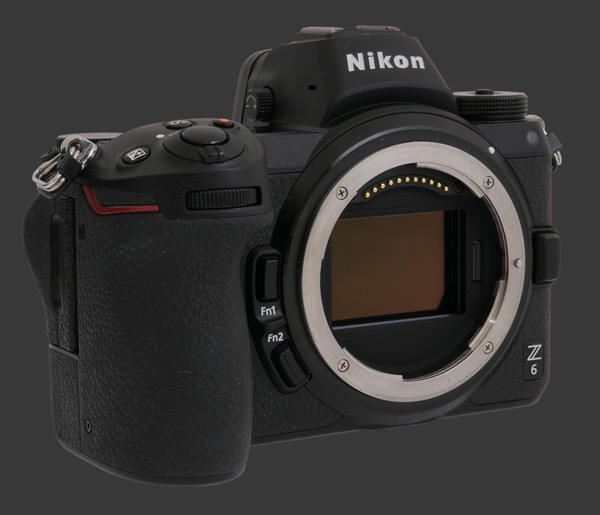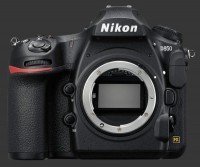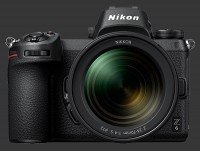Nikon Z6 Review
Nikon Z6 Performance - How well does it take pictures?
NOTE - Although the Z6 looks identical to the Z7 and both cameras feature state-of-the-art sensors, they offer significantly different trade-off when it comes to image rendition. If there is one page that must be read in this Nikon Z6 Digital Camera Review, here it is.
Ultimately, it is the image quality that makes a camera worth buying. For a digital SLR, image quality greatly depends on the lens used. While color, noise, contrast and exposure are properties of the camera, distortion, vignetting and chromatic aberrations are properties of the lens. Sharpness depends on the weakest link. So, the camera cannot capture more details than the lens lets through. Conversely, a lens can transmit a greater amount of details than the sensor can capture.
Image Noise & Sharpness
The Nikon Z6 sensor features some of the largest pixels among modern digital cameras. What this takes away in resolution, it more than makes up for it when it comes to image noise. 24 Megapixels of resolution is sufficient to produce moderately large prints, up to 24" x 16", that look very sharp even under close inspection. The sensor does not use an anti-alias filter and so it really captures a maximum amount of details with native lenses which are designed to resolve far more resolution.
Image noise is absent from ISO 50 to 800 and virtually unnoticeable until ISO 3200 where it can only be seen at maximum magnification. This is less noise than the Z7 which needs to apply a fair amount of noise-reduction to keep images from becoming grainy above ISO 800. As a result, High-ISO images appear sharper on the Z6, despite being of half-the-resolution of images from the Z7, since noise-reduction actually reduces details too.

Only a hint of noise starts appearing at ISO 3200 which is only truly visible when seen at 100% or on maximum-sized prints. ISO 6400 performs nearly identically. These sensitivities clearly preserve fine details with minimal impact on dynamic-range, contrast and color. Even a mid-size 18" x 12" print looks very sharp and free of visible image-noise.
The first stop where details start becoming affected is ISO 12800. That ISO shows some luminance-noise with a minor effect on details. It lifts the noise-floor though, causing a noticeable loss in dynamic-range. Color and overall contrast remain very good though. Mid-size prints certainly look quite good as long as they are not very low-key, since image-noise is always more visible in shadow areas.
At ISO 25600, luminance noise is more present and starts looking like grain. Shadow details get muddied yet color and contrast hold up really well. Dynamic-range gets reduced a little too but not significantly so. The last standard sensitivity is ISO 51200 which is where chroma noise begins to appear. This eats away image-details, further reducing possible print sizes to more common formats. Small prints still look great though.
The expanded sensitivities of ISO 102,400-204,800 are there mostly for emergencies. They both show significant chroma noise and details are completely smudged. A small print from ISO 102,400 can still be useful as it maintains reasonable color and contrast. Higher than that is not really useful.
Sharpness from the Z6 is spectacular. There are more parameters than ever to control image rendition. Sharpness itself is controlled in ¼ steps along a -3 to 9 scale. The steps are extremely fine with a default that depends on the selected Photo Style. A setting of +3 gives optimal sharpness without any artifacts. One can easily push this until +4 for added sharpness with minimal impact.
The Nikon Z6 features an additional control for mid-tone sharpness. This setting has a ±5 range in ¼ steps. Increments are arbitrary and not in any particular unit, so consider this 41 total steps with very fine differences between them. Pushing it to around +2 produces images with a crisp look. The Clarity parameter that Nikon introduces a few generations ago works the same way but for micro-contrast. This time, optimal results are achieved around +1½.

Metering & Color
The default Multi-Segment metering of the Z6 is quite accurate and produces balanced exposures under reasonable conditions. Highlights are clipped when near the edge of the frame which is typical for segmented metering patterns. Exposure is rarely off by much and better than on DSLRs that do not have access to data from the image-sensor for metering. The Highlight Weighed metering mode is extremely conservative which tends to massively underexpose in the presence of bright highlights. Spot and Average metering work exactly as expected.
Image parameters are plentiful and adjustable in very fine steps. There are six picture styles offering various degrees of realism. The Standard style is reasonably close to reality with slightly exaggerated colors. This is fixable by shifting Hue +1 and Saturation -1½. Also pushing Contrast down -½ restores a tiny amount of clipping without making images dull. Alternately, one can start with Neutral and go the other way around as done for the Z7 review.
Automatic White-Balance from this mirrorless is quite good. There are a total of 4 Auto settings now. The 3 under Auto vary in how they deal with color-cast from typical of tungsten lighting. Auto 0 produces neutral colors, even under dim artificial light which is something the majority of Nikon DSLRs struggle with. It occasionally still leaves a slight yellow cast, yet rarely a strong one. There are Auto 1 and Auto 2 settings as well. The former keeps some of the warmth, the latter all of it. A Natural Light Auto setting was introduced with the Z6 and Z7 twins. This is mostly useful in mixed lighting situations where it makes natural light look neutral and lets other types of lighting fall in place.
Although one would expect the Z6 to deliver more dynamic-range than the Z7 and D850 since it has larger pixels, digitalization becomes the limiting factor. All these cameras use a 14-bit read-out which means they cannot exceed 14 stops without introducing a non-linear response. Such as response causes banding in lower levels and even reveals the on-sensor Phase-Detection pixels, which form the lower limit. Larger pixels on the Nikon Z6 sensor contribute to maintaining a large dynamic-range at higher sensivitities than most digital cameras. Starting at ISO 800, the Z6 manages to capture a full-stop more dynamic-range than even the class-leading D850.

Speed & Autofocus
Digital cameras have been increasing in speed and mirrorless ones improving even faster than DSLRs. This means that the gap is getting narrower overall, with many performance aspects of mirrorless digital cameras surpassing what is possible with a flipping mirror and mechanical shutter. Bandwidth is usually the next limiting factor after mechanical ones which is why lower-resolution cameras can shoot faster for longer. This is the case of the Z6 vs Z7.
The Nikon Z6 can continuous shoot full-resolution images at 12 FPS for 42 JPEG images or 24 RAW files. At this speed, a burst lasts just 2 or 3 seconds. Slowing down to 5.5 FPS stretches this beyond 5 seconds while gaining Continuous AF and AE Metering. Given that the Z6 relies exclusively on a single XQD memory card, it is capable of clearing its buffer quite quickly, so only short pauses are needed between bursts. Although reasonable, this is insufficient for professional action and sports photography.
This mirrorless is generally quite responsive. Dials and buttons get an instant response with changes to exposure parameters and other settings all happening instantly. The shutter-release requires some getting used to. It feels sticky only because of the Electronic First-Curtain Shutter (EFCS) which is on by default. What happens is that the shutter-release occurs immediately yet only the closing of the shutter is heard since that is mechanical. The electronic portion is completely silent. When Silent Shooting is enabled, then the Z6 is completely quiet.
The performance of the Nikon Z6 is characterized by the following numbers:
- Power On: About 1s. Good.
- Autofocus: ¼s even down to very low light. Excellent!
- Shutter-Lag: Nearly instant. Great.
- Shot-to-shot speed: 1/3s. Good.
- Instant Review: ¾s. Below average.
- Playback: Around ¼s to enter, less than ½s to exit. Good.
- Power Off: Instant. Very good.

The built-in Phase-Detect AF system of the Z6 is impressive. It is sensitive down to very low light levels and remains quick and precise. Since it’s on-sensor, it cannot be misaligned and so there is no need for AF Fine-Tuning. Even in dim indoor lighting, focus is locked in around ¼s. This is impressive for a mirrorless and is near the performance of high-end DSLRs.
Continuous AF works for targets that move relatively slowly and predictably. With fast subjects, the camera has trouble keeping up and often lags behind. This is particularly noticeable when using bright apertures that produce a shallow depth-of-field. Again, for the photography where speed is essential, this is not the right camera.
Unsurprisingly, shot-to-shot speed which requires less throughput on the Z6 are faster than on the Z7. Oddly though, entering Instant Review is visible slower. There should be no real reason for, so it might be due a different firmware version.
Battery-life is very short and drops noticeable as temperatures approach freezing. Even Airplane mode does not save it from poor battery-life. At the very least, 2 extra batteries are needed for a full day of photography. Even reducing the EVF and LCD brightness only provides a minimal improvement, since their circuitry dominates power consumption. Also, unlike a DSLR, reviewing images less frequently does not make much difference since the EVF or LCD remains on the same amount of time.
Nikon Z6 Conclusion

Nikon launched the Z-platform by introducing the Nikon Z6 and Z7 simultaneously. Understandably, the Z7 drew more attention due to its considerably higher-resolution and immediate comparison to the D850 reviewed here
Nikon D850 which remains one of the best DSLRs on the market. The Z6, however, packs virtually the same feature set while costing $1000 USD less and still managing to shoot faster and in lower-light.
The 24 megapixels BSI-CMOS sensor in the Nikon Z6 produces exceptionally clean images with crisp details, extremely low noise and and top-notch low-light performance. This Full-Frame Mirrorless Digital Camera also record superb 4K Ultra-HD video. Combined with a powerful EXPEED 6 processor, the imaging pipleline can sustain 12 FPS continuous shooting at full-resolution.
The Images quality of the Z6 is excellent. Noise levels are extremely through ISO 3200 which puts it ahead of the Z7 and D850. With 24 MP of resolution, this makes for beautiful 24" x 16" prints even for photography taken in moderately low-light. The 14-stop dynamic-range delivered by the Z6 is very good and manages to keep up better than most digital cameras as ISO is increased. Metering is among the best in class and consistently produces well-balanced exposures.
The image processing pipeline of this full-frame camera is the most sophisticated to date with very fine controls over detail and color rendition. Sharpness, color and contrast are all highly tunable to match the most demanding photographers. Even the Automatic White-Balance system is unusually reliable and manages to render neutral colors for the majority of scenes.
Although 12 FPS is quite fast, the Z6 does not the buffer depth demanded by professional action photographers. Its 273-Point AF system is reliable, very sensitive and quite fast yet insuficiently to nail focus on every frame during a continuous burst, even though the continuous drive slows down to 5.5 FPS to do so. The camera itself though is extremely responsive and never holds the photographer back. The main performance drawback of very short battery-life is easy to overcome by purchasing additional batteries.
The ergonomics of the Nikon Z6 show a compromise in design. The camera body offers all controls needed to for efficient operation while keeping some Nikon traditions that could be clearly improved. It gives a certain familiarity to existing Nikon users that are the primary market for the Z-platform, at least until the family of lenses available becomes more compehensive.
The Z6 and Z7 are the first Nikon interchangeable lens cameras to offer built-in image stabilization which makes a world of difference. This 5-axis stabilization system is extremely reliable and performs very will at all focal-lengths. It can even perform 3-axis compensation while delagating the remaining to axis to VR elements inside adapted F-mount lenses.
A lof of emphasis has been put on the viewfinder experience. This is traditionally one of the major sore-points of mirrorless cameras, although nowadays EVFs have more advantages than inconveniences compared to OVFs. The 0.5" EVF in the Z6 offers a class-leading 3.7 megapixels with a large 0.8X magnification, 100% coverage and a built-in Eye-Start Sensor. Resolutionwise, this EVF is completely outstanding. The view is large and crisp with very natural contrast. All is not perfect though as the preview does not consistently manage to be Exposure Priority or show the resulting white-balance.
In the end, the Nikon Z6 delivers an exceptional value among Full-Frame Digital Cameras, mirrorless or not, without compromising on features or performance. Low-light enthusiasts and videographers even get better performance out of the Z6 than the more costly Z7.
 |
Please Support Neocamera
All information on Neocamera is provided free of charge yet running this website is a huge endeavor. Purchases made via affiliate links found throughout the site help keep it running and up-to-date. There is no additional cost to you, so please consider buying via these links to our affilates:
If you found any information on this site valuable and did not purchase via our affiliate links, please considering donating via PayPal:
Any amount will be greatly appreaciated. Thank you for your support!
Nikon Z6 Highlights

Sensor-Size: 36 x 24mm

Actual size when viewed at 100 DPI
| 24 Megapixels Mirrorless | ISO 50-204800 |
| Nikon Z Mount 1X FLM | Shutter 1/8000-30s |
| 5-Axis Built-in Stabilization, 5-Stop Improvement | Full manual controls, including Manual Focus |
| 0.50" Built-in EVF 3.7 Megapixels (0.80X) | Custom white-balance with 2 axis fine-tuning |
| Automatic Eye-Start sensor | Spot-Metering |
| 2 Axis Digital Level | Hot-Shoe |
| Weatherproof | Stereo audio input |
| Built-in Dust Reduction | Lithium-Ion Battery |
| 12 FPS Drive, 42 Images | XQD, CF Express Type B |
| 3840x2160 @ 30 FPS Video Recording | |
| 3.2" LCD 2.1 Megapixels |
Updates
2024.05.09

Fujifilm GFX100 II Review
Flagship 102 Megapixels Medium-Format Mirrorless Digital Camera with 8-Stop 5-Axis IBIS, 8 FPS Drive, 8K Video and 400 MP Super-Resolution capture in a weatherproof and freezeproof body with dual control-dials and dual memory-card slots.
2024.04.03

Fujifilm X-T5 Review
Newest Fujifilm flagship boasting a 40 MP APS-C sensor, 5-axis IBIS with 7-stop efficiency, 15 FPS continuous drive, 6.2K Video capture, dual control-dials and dual SDXC UHS-II slots in a sturdy weatherproof and freezeproof body.
2023.11.20

Best Digital Cameras of 2023
Find out which are the Best Digital Cameras of 2023. All the new Mirrorless Digital Cameras from entry-level to high-end professional.
2023.07.10

Fujifilm X-H2 Review
40 Megapixels APS-C Hybrid Mirrorless Digital Camera with 7-stop IBIS. Fastest shutter ever and 8K video capture. Large builtin EVF with 0.8X magnification and 5.8 MP, plus an Eye-Start Sensor. Packed with features and large number of controls in a weatherproof and freezeproof body.
2023.05.07

Sony FE 20-70mm F/4G Review
Review of the unique Sony FE 20-70mm F/4G lens. The optical zoom of this lens spans ultra-wide-angle and medium focal-length coverage, making it one of the most versatile Full-Frame lenses on the market.
2023.01.15

Huion Inspiroy Dial 2 Review
Review of the Huion Inspiroy Dial 2 tablet, a medium sized drawing surface with dual dials and customizable buttons. Connects via USB-C or Bluetooth 5.0 with Windows, Linux and Android support.
2022.12.08

How to Pack for a Photo Trip
Find out how to pack for a travel photography trip, carry your gear safely while meeting airline regulations.
2022.11.13

Best Digital Cameras of 2022
The best digital cameras of 2022. A short list of the most outstanding models in their respective categories. Choose one for yourself or as a gift.
2022.09.21

Pentax DA* 60-250mm F/4 SDM Review
Review of the Pentax DA* 60-250mm F/4 SDM, the constant-aperture telephoto zoom with the highest zoom-ratio on the market.
2022.09.20

Pentax DA* 50-135mm F/2.8 SDM Review
Review of the Pentax DA* 50-135mm F/2.8 SDM, the lightest professional telephoto zoom native to the K-mount.
2022.09.10

Pentax DA* 11-18mm F/2.8 DC AW Review
Review of the Pentax DA* 11-18mm F/2.8 DC AW, the widest professional ultra-wide zoom native to the K-mount.
2021.11.24

50 Gifts Under $50 For Photographers in 2021
50 Gifts photographers will love. All for under $50 USD. 2021 Edition.











